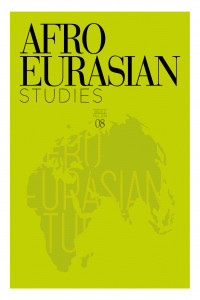Economic and Commercial Relations of the Prophet Muhammad with the Jews
Economic and Commercial Relations of the Prophet Muhammad with the Jews
___
- Apak, A. (2012). Anahatlarıyla İslam Tarihi (8 b., Vol 1). İstanbul: Ensar Neşriyat.
- Bal, F. (2015). Arap Yarımadasında Ticaret: Hz. Peygamber Dönemi ve Dört Halife. İstanbul: Beka Yayınları.
- Bozkurt, N., & Küçükaşcı, M. S. (2003). Medine. 23, 305-311. DİA.
- Brockelmann, C. (1992). İslâm Ulusları ve Devletleri Tarihi. (N. Çağatay, Trans.) Ankara: Türk Tarih Kurumu.
- el-Buhârî, E. A. (2001). el-Câmiu’s-Sahih. Beyrut: Dâru Tuki'n-Necat.
- Emin, A. (1950). Fecru'l-İslam. Kahire: Mektebetu’n-Nehdati’l-Mısriyye.
- es-Semhûdî. (1326). Vefau’l-vefâ bi ahbari dâri’l-Mustafa (Vol 1). Kahire.
- Hamidullah, M. (1990). İslam Peygamberi. (S. Tuğ, Trans.) İstanbul: İnsan Yayınları.
- Hamidullah, M. (İstanbul). Makaleler. (İ. S. Sırma, Trans.) 1986: Beyan Yayınları.
- Ahmed b. Hanbel, (nd). Müsned, Kahire: Müessesetü'l Kurtuba.
- Hasan, H. l. (1987). Islam Tirihi (Vol 1). (İ. Yiğit, & S. Gümüş, Trans.) İstanbul: Kayıhan Yayınları.
- İbn Hişam, (1955). es-Sfratü'n-Nebeviyye (Vol. 3). (M. es-Sekka, Trans.) Beyrut.
- İbn Kesir, (1994). EI-Bidaye ve'n-Nihaye Büyük Islam Tarihi (Cilt 2). (M. Keskin, Trans.) İstanbul: Çağn Yayınlan.
- Lecker, M. (nd). İslam Öncesi ve İslam'ın İlk Döneminde Medine/Yesrib Pazarı Üzerine. 2(4), 157-172. (M. M. Söylemez, Trans.)
- İbn Mace, (nd). Sünen (Vol II). Beyrut: Daru'l Fikr.
- En-Nesai, (1991). Sünenü'l Kübra, Beyrut: Daru'l Kutubü'l İlmiyye.
- İbn Sa'd, (1960). et-Tabakatü'l-Kübra (Volt 1). Beyrut.
- Safa, M. (2015, Ocak). Hicret Sonrası Medine’de Sosyal ve Dini Hayat. Toplum Bilimleri Dergisi, 9 (17), 355-398.
- Sırma, İ. S. (1994). Medine Vesikasının Mevsukiyeti ile ilgili Bazı Veriler. Bilgi ve Hikmet (5), 48.
- Sourdel, D. (1995). İslâm. İstanbul: İlim Yayınları.
- Sönmez, A. (1984). Resulullah'ın Diplomatik Münasebetleri. İstanbul: İnkıap Yayınevi.
- Tabakoğlu, A. (2013). İslam İktisadına Giriş (3 b.). İstanbul: Dergah Yayınları.
- Tabarani. (h. 1425). Mu'cemü'l Evsad (Vol. V). Kahire: Daru'l Harameyn.
- Taberi, E. C. (nd). Tarihi Taberi (Vol. 2). (M. F. Tunca, Çev.) İstanbul.
- Tirmizi. (1978). Sünen (Vol. V). Kahire: Mustafa El Halebi.
- Vakıdi, (1984). Kitabü'l-Meğazi (Vol. 1). (M. Jones, Trans.) Beyrut.
- Yüksel, A. T. (2018, 08 05). yenidunyadergisi. http://yenidunyadergisi.com: http://yenidunyadergisi.com/hz-peygamberin-sav-ticari- faaliyetleri-bazi-emir-ve-yasaklari-ve-gecimi/ adresinden alındı
- ISSN: 2147-110X
- Yayın Aralığı: Yıllık
- Başlangıç: 2012
- Yayıncı: Musiad (Independent Industrialists and Businessmen's Association)
Inventory of the Islamic Economics and Finance Studies Carried Out in Turkey and Its Evaluation
Zihniye OKRAY, Sultan OKUMUŞOĞLU, Cemaliye DİREKTÖR, Anjelika HÜSEYİNZADE ŞİMŞEK
Asylum Seeker and Refugee Crisis as a Humanitarian Tragedy in the Contemporary World
Economic and Commercial Relations of the Prophet Muhammad with the Jews
